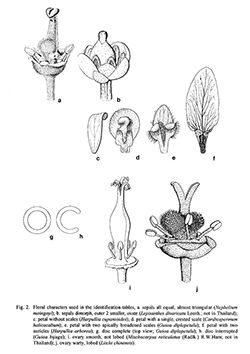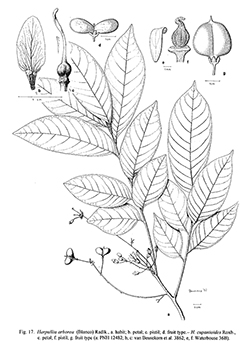e-Flora of Thailand
Volume 7 > Part 1 > Year 1999 > Page 211 > Sapindaceae > Harpullia
2. Harpullia cupanioides Roxb.wfo-0000715826
Fl. Ind. ed. Carey 2: 442. 1824; Radlk. in Engl., Pflanzenr. 98: 1444. 1934; Leenh. & Vente, Blumea 28: 26. 1982 (see also for complete synonymy); Yap in Tree Fl. Mal. 4: 444. 1989; Leenh. & Vente in Fl. Males., Ser. 1, Spermat. 11: 606, fig. 46g, h. 1994. Fig. 2c, 17e-g.
Accepted Name : This is currently accepted.
Description : (Shrubs or) trees up to 20(–40) m high, bark grey, smooth to pustular; only terminal bud of young parts densely pilose. Leaves (1–)3–6(–7)-jugate. Leaflets ovate (lower ones) to elliptic to obovate (upper ones), 5–36 by 2–15 cm, herbaceous to chartaceous; base acute to rounded to attenuate; apex rounded to obtusely acute or acuminate; (sub)glabrous on both sides. Inflorescences up to 85 cm long. Flowers white, fragrant, up to more than 1 cm wide. Sepals elliptic to suborbicular, 3–6 by 2.5–4.5 mm, persistent in fruit, light green. Petals obovate, 11–24 mm long, fleshy, white to light yellow, claw and auricles absent. Stamens 5 (or 6); filaments 2.5–3.5 mm long, light green; anthers 1.5–3.5 mm long, light orange. Fruits red, stipe up to 3 mm high, lobes higher than long, pilose outside, glabrescent, glabrous to (glandular) subpilose within, wall thin, leathery. Seeds shiny brown to black; arilloid orange.
Thailand : NORTHERN: Mae Hong Son (Doi Pha Pong, Mae Surin, Muang Fang, Tum Pea), Chiang Mai (Doi Chiang Dao, Doi Suthep, Maesa Botanical Garden), Nan (Khun Mo Tom), Phrae (Huai Rai, Huai Surin), Phitsanulok (Tung Salaeng Luang NP); NORTH-EASTERN: Nong Khai (Phonpisai); EASTERN: Chaiyaphum (King Ban Yang, Nong Bua Daeng); SOUTH-WESTERN: Kanchanaburi (Sangkhla Buri, Tum Pea, Wangka); SOUTH-EASTERN: Chon Buri (Ban Sadet, Khao Khiao); PENINSULAR: Surat Thani (Ko Chao, Ko Samui, Pathio), Krabi (Ao Nang), Trang (Khao Chong, Palien), Pattani (Ban Sai Kao).
Distribution : From India (Assam, Andaman Islands) and Bangladesh (type) to S China and Indochina to Australia (Northern Territory).
Ecology : Primary and secondary evergreen to deciduous forests, more rarely in light forests, teak forests, tidal forests, scrub, or on open places, often on slopes, along river banks, ravines, beaches; usually on dry soil, often limestone; sea level up to 1,200(–1,800) m alt. Flowering and fruiting: more or less throughout the year.
Vernacular : Ba han than (บาหานธาร), khang khao (ขางขาว)(Northern); luk kapok ma (ลูกกะโปกม้า), mai phrik pa (ไม้พริกป่า)(Southeastern); ngonkai dong (หงอนไก่ดง)(Peninsular).
Uses: The wood is used as firewood and for charcoal. The bark may be used as fish poison.


